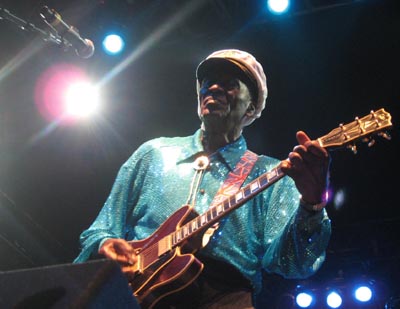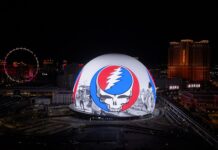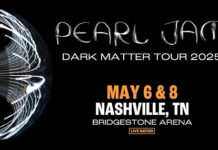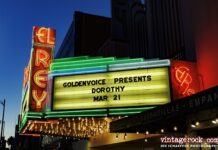Concert Review by Shawn Perry
Hot, hot, hot. That might be a good way to describe the 29th annual Long Beach Blues Festival. The music was hot, the food was hot and the weather was…well, it was pleasantly warm. For the previous 28 years, the festival took place on a dry and dusty football field at Cal State University Long Beach (CSULB) over Labor Day weekend — when the digits top out in the upper registers of Southern California thermometers. This year, it moved to the Rainbow Lagoon Park, situated between the Hyatt Hotel and the Long Beach Arena, and directly across the street from Long Beach Marina. The off-shore breeze kept the proceedings from overheating and the fans from melting. As the twilight of the evening exhaled its earthy breath, the sweatshirts and blankets came out. That didn’t stop the musicians from blazing up around an open fire of savory blues.
Everyone from Little Richard to the Allman Brothers Band has played this legendary festival, and this year offered the same caliber of talent. Chuck Berry, at the ripe old age of 81, headlined the Saturday show, while bluesman Taj Mahal stepped in for Sly & The Family Stone and closed the festival on Sunday. Either way, it was two days of electrifying blues, jazz, rock and R&B from 20 world-class artists on two stages.
So it was that on Saturday, I arrived just in time to miss Roy Rogers, Joey Joel and the immortal Pinetop Perkins. At 95, the blues pianist occasionally leaves his home stand in Austin, Texas, to participate in festivals of this sort. Fortunately, he stuck around to sign a few autographs while Roy Young paid the first of many tributes to James Brown, performing “It’s a Man’s Man’s Man’s World.” Then he did the unthinkable — a bluesy version of REM’s “Everybody Hurts.” I commend his bravery for turning in a soulful reading.
After munching on corn on the cob, washed down by my first of many Sierra Nevadas, I caught a couple of numbers from Robert Francis on the second stage. Throughout the festival, it seemed like the breakneck adventure of the blues was more attacked and attended to by the lesser-known acts playing the smaller, second stage. Certainly, the enthusiasm displayed by fans was immediate and intense, almost like a club setting.
The sun began to set, and the Dirty Dozen Brass Band hit the main stage for a wily set of funky brass-based bebop with a whisper of blues to keep it real. They took the cue from Roy Young by pumping the crowd up with a heavy-handed, groovin’ take of James Brown’s “Get Up (I Feel Like Being A) Sex Machine.” Everyone lapped it up, setting the mood for Mama’s Boys, a local blues group I’ve seen around town. They played the last set on the second stage before ceding the night to the Godfather of British Blues, John Mayall.
 I spoke to Mayall briefly before his set, and he told me he had played the festival before and enjoyed the ambiance. As expected, the audience were politely receptive to the man who launched the careers of Eric Clapton, Mick Taylor, Mick Fleetwood, John McVie and Walter Trout. I scanned the crowd — a rich mixture of black and white, red and blue, purple and pink. One woman donning a Barack Obama T-shirt danced by, a parasol spinning round and round, shading her from the hot ball of fire dropping in the sky. Not a care in the world and none to be had. Isn’t that what the blues are all about?
I spoke to Mayall briefly before his set, and he told me he had played the festival before and enjoyed the ambiance. As expected, the audience were politely receptive to the man who launched the careers of Eric Clapton, Mick Taylor, Mick Fleetwood, John McVie and Walter Trout. I scanned the crowd — a rich mixture of black and white, red and blue, purple and pink. One woman donning a Barack Obama T-shirt danced by, a parasol spinning round and round, shading her from the hot ball of fire dropping in the sky. Not a care in the world and none to be had. Isn’t that what the blues are all about?
As the Bluesbreakers started to play, I glanced over at the Long Beach Arena, where I’ve seen Led Zeppelin, Black Sabbath, the Who, Bob Dylan and dozens of others. It used to sport a pinkish, beige hue; now it looks like a giant fish tank, with Wyland-like marine life swimming around its perimeter. Far from being an eye sore, it still looks odd from any angle.
I wondered if Mayall had ever played there. It’s likely he doesn’t remember when you consider he’s recorded over 50 albums and toured the world for almost as many years. The Bluesbreakers — guitarist Buddy Whittington, drummer Joe Yuele and bassist Hank Van Sickle — warmed up the audience with a couple of choice cuts from In The Palace Of The King, Mayall and the Bluesbreakers’ tribute to the late and great Freddie “The Texas Cannonball” King.
Once the “Bossman” joined the band, all bets were off. At 74, Mayall looked exceptionally sprite and in excellent form, playing guitar and organ, singing up a storm, pulling out plums like “An Eye For An Eye,” and teaming up with wife Maggie Mayall for a lively “Turn Me Loose.” Maggie reminded the audience that it was 30 years ago on Labor Day weekend that she and her husband first met. They were married four years later.
Taking a stroll around the festival, I couldn’t help but notice the countless Chuck Berry fans, one wearing a T-shirt that said, “The True King of Rock and Roll,” and another guy hoisting a placard proclaiming, “Chuck Berry Invented Rock N’ Roll.” The excitement of seeing Chuck Berry was mounting. When he finally came on, opening with “Roll Over Beethoven,” it was like all time and space had evaporated, and it was 1956 all over again.
In his turquoise lame shirt and captain’s hat, Berry defied the clock by swinging his guitar around like Keith Richards in a gun fight, duck walking on occasion, and essentially running the show his way. He’d sporadically miss his cues, and his playing was pure slop at times, but the essence and feel of everything the man has come symbolize was firmly intact. “Rock N’ Roll Music” and “Nadine” intuitively rolled out, while “My Ding-a-Ling” simultaneously amused and shocked the exhausted audience.
The jamming between Berry and his makeshift band was loose and wild. “Oh Carol” was pure poetry, “Little Queenie” meandered but immediately picked itself up. After “Sweet Little 16,” a dozen women of all shapes and sizes joined Berry on stage for a hip-shaking “Johnny B. Goode.” Taking his bows, Chuck Berry is liable to keep going until the day he meets his maker. That in itself could prove to be an interesting turn of events.
Day 2
Sunday’s show was a bit more restrained, but nonetheless exciting. I arrived just in time to catch Stax Records singer and songwriter Eddie Floyd. In addition to performing his own career defining hit, “Knock On Wood,” Floyd graciously covered “(Sittin’ On) The Dock of the Bay” as a tribute to his old friend Otis Redding. Then he tipped his hat to another Stax label mate, the recently departed Isaac Hayes, with “Soul Man.” Floyd mentioned that Hayes will be featured in an upcoming film called, coincidentally enough, Soul Men.
The Average Johnsons raved it up on the second stage before Grammy-nominated, veteran blues harp player Charlie Musselwhite came out for a rousing set of white-knuckle boogie. I munched on pork ribs and beans, drowning in another slurp of Sierra Nevada, and dug in for “Church Is Out,” Musselwhite’s ode to forgetting your cares, as well as the autobiographical “Blues Over Turkey.”
I took in the audience — as I had the day before — feasting on the sounds and watching all varieties of sportos, middle managers, hippies, yippies, cops (armed and brandishing cobs of corn), weekend warriors, blues fanatics, blues enthusiasts, chicks, chumps, , Rhodes scholars, Generation Xers, rockers, mockers, funksters, soul brothers, sweet sisters, comedians, confused adolescents, tie-dyed grannies, baby-slinging mommies, and loads of beer-bellied-Hawaiian-shirt-wearin’ daddy-o’s. What an education in people watching!
After Andy Walo finished up a scorching set on the second stage, highlighted by a spastic beating of John Lee Hooker’s “Boom Boom,” the highlight of the day — maybe of the whole festival — took over the main stage and never strayed off the beaten path. This was Booker T. Jones without the MG’s, switched on to jam and sway with a selection of tunes that read like a history lesson in R&B. Jones sat behind his Hammond B3 directing traffic and taking names.
He crooned out “Ain’t No Sunshine,” a song he produced for Bill Withers. Supported by a superb three-piece band that included guitarist Vernon “Ice” Black, Jones dug in deeper, performing “Bad Under A Bad Song,” co-written by the keyboardist and popularized by Albert King, Cream and Jimi Hendrix. An instrumental of the Young Rascals hit “Groovin” set the stage for the one-two punch of Jones’ greatest contributions to pop music — “Green Onions” and “Time Is Tight.” It was enough to incite a conga line that snaked its way around the grounds. Once Jones said, “Thank you so much. That’s our show,” my heart sank and I almost felt like calling it a day. But there was still one more act to go.
I’ll be honest, I’m not all that familiar with the stylings of Taj Mahal. I saw him on The Rolling Stones Rock And Roll Circus from 1968, and came away fairly impressed. I mean, if the Stones dig him, he’s alright by me. In the late 60s, my girlfriend, her sister and some friends went to see Taj Mahal at a small club near Rice University in Houston, Texas, and ended up inviting him back to their place for a little weed. Mahal sat on the front porch, strumming away on his acoustic guitar until the sun came up. But really — what do you make of a guy who named himself after a mausoleum in India? The minute the Taj Mahal Trio played their first note in Long Beach, it all started to make sense.
Cool and refined in a white jumpsuit and topped off with a matching, wide-brimmed Panama hat, Mahal took charge, mixing bits of folk, reggae and jazz into his blues-driven repertoire. He played a few tunes from his new album Maestro, slipped in between blues standards like T-Bone Walker’s “Mean Old World.” Jumping from electric guitar to keyboards, then over to acoustic, the world didn’t seem so mean as Mahal wooed the sun-baked crowd into a blissful hush, leaving an indelible imprint on the soul, smoothing over the rough edges of the weekend. “I like the blues in every color the blues come in,” he announced toward the end of his set. It was a beautiful ending to a perfect weekend.





















